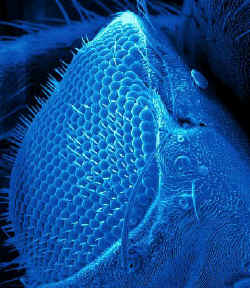Equations for an Embryo

Physicists are famous for studying the world by drastically simplifying it in their mathematical equations. In the October issue of Physical Review E a pair of physicists takes that approach with one of the miracles of Nature: embryo development. They present a mathematical model for cellular differentiation–the complex process that creates the many specialized cells in a baby from the identical cells of an embryo. They show that even a one-dimensional model reproduces some phenomena observed in real fly embryos–but only if they account for the “single unit” nature of cells, rather than assuming that many cells make up one large “bag of fluid,” as previous theories have done.
The development of a fly’s eye occurs as a slow wave of differentiation propagates across the set of undifferentiated cells, from one side to the other. This process is initiated by signals from cells outside the eye and is supported by chemical signals the cells send to their neighbors. The wave of differentiation can be halted by lowering the temperature a bit, according to biologists, but mathematical models that represent the eye as a large fluid in which the signals diffuse can’t reproduce this “propagation failure” in a reasonable way. They also have difficulty generating basic observations of developing body parts of other animals, such as the ability of this type of wave to reverse itself if the outside signal isn’t strong enough.
Gábor Fáth, of the University of Cambridge, and Zbigniew Domanski, of the University of Lausanne in Switzerland and the Technical University of Czestochowa in Poland, found that these shortcomings could be overcome by using a “discrete” model–one where the concentration of the “morphogen” chemical exists only at specific locations (“cells”) and changes in steps, rather than varying continuously over all places in space. Surprisingly, the model is extremely simple and ignores all of the complexities of biochemistry.
Fáth and Domanski assumed a single column of cells, where each cell is influenced only by the amount of morphogen at its own location and that of its two neighboring cells. The cells begin in the undifferentiated state and switch to the differentiated state when their local morphogen concentration rises above a threshold value. Cells also manufacture and absorb the morphogen according to a simple formula, depending on their state, a simplification of complicated biochemical reactions.
According to the model, the process starts when an outside chemical signal is applied to the first cell in the column with a certain strength and duration. The researchers found three different possible outcomes, depending on the model parameters: (1) The wave of differentiation propagates straight through the cells, (2) the wave stops at a certain cell position, preventing the remaining cells from differentiating (propagation failure), or (3) the wave reverses course, so that the cells “dedifferentiate,” but at a different rate from the differentiation phase (hysteresis). Developmental biologists have observed all of these processes with real cells, but it was not clear whether they could be captured in a simple mathematical model.
The authors explain that the discrete model is needed because cells are large objects, compared to other length scales related to diffusion. “The ‘discrete’ approach enables us to model new phenomena” in biology, says Domanski, and address questions such as how genetic signals combine to create the “wave of differentiation” and how biochemical reactions conspire to regulate its progress. Alan Bishop of Los Alamos National Laboratory in New Mexico says researchers studying many areas of non-linear physics, including biological physics, have also recently concluded that discrete models yield new types of phenomena not seen with continuum models.


